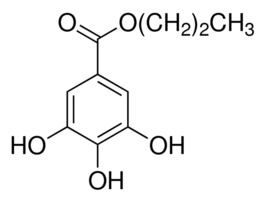All AbMole products are for research use only, cannot be used for human consumption.

An antioxidant that exhibits antimicrobial activity. Propyl gallate has been reported to be an effective antioxidant-based hepatoprotector, both in vitro and in vivo. It has also been shown to prevent neuronal apoptosis and block the death of neurons exposed to FeSO4/GA as well as partially protect endothelial cells against TNF-induced apoptosis. However, propyl gallate induced single strand breaks in DNA at concentrations higher than 0.25 μM when it was combined with copper concentrations at 5 μM and above. Another report, however, found that incubation of isolated rat hepatocytes with propyl gallate at concentrations of >1 mM induced cell killing, whereas, a lower concentration of propyl gallate > 0.5 mM resulted in a ladder formation of soluble low-molecular weight DNA fragments, characteristic of apoptosis.
| Molecular Weight | 212.2 |
| Formula | 3,4,5-(HO)3C6H2CO2CH2CH2CH3 |
| CAS Number | 121-79-9 |
| Form | Solid |
| Solubility (25°C) | ethanol: 50 mg/mL |
| Storage |
Powder -20°C 3 years ; 4°C 2 years In solvent -80°C 6 months ; -20°C 1 month |
[4] No authors listed. Safety and efficacy of propyl gallate for all animal species
| Related Products |
|---|
| PCL-PEG-MAL
PCL-PEG-MAL is an amphiphilic block copolymer consisting of polycaprolactone (PCL), polyethylene glycol (PEG) and maleimide (MAL) functional groups. PCL-PEG-MAL is used in targeted delivery systems, surface modification of nanomaterials, functionalisation of biomaterials and biosensing technologies for specific chemical linkages or biomolecular immobilisation. |
| DSPE-PEG-Streptavidin
DSPE-PEG-Streptavidin is an important biocoupling molecule widely used in biomedical research, especially in drug delivery, targeted therapies, immunodiagnostics and biosensors. Through the specific binding between streptavidin and biotin, DSPE-PEG-Streptavidin can help to achieve efficient loading and targeted action in targeted delivery systems. In addition, the molecule is widely used in molecular imaging and bioassays, especially for molecular recognition using the strong affinity between streptavidin and biotin in assay platforms that require high sensitivity and specificity. |
| E7107
E7107 is a first-in-class precursor messenger ribonucleic acid (pre-mRNA) spliceosome inhibitor. |
| KL044
KL044 is a stabilizer of the clock protein cryptochrome (CRY). KL044 is a potent chemical probe with a pEC50 value of 7.32, leading to the extension of the circadian period and repression of Per2 activity. |
| 2-(2-Methylphenoxy)-4H-1,3,2-benzodioxaphosphorin 2-oxide
2-(2-Methylphenoxy)-4H-1,3,2-benzodioxaphosphorin 2-oxide is a biochemical material that can be used in scientific research. |
All AbMole products are for research use only, cannot be used for human consumption or veterinary use. We do not provide products or services to individuals. Please comply with the intended use and do not use AbMole products for any other purpose.


Products are for research use only. Not for human use. We do not sell to patients.
© Copyright 2010-2024 AbMole BioScience. All Rights Reserved.
